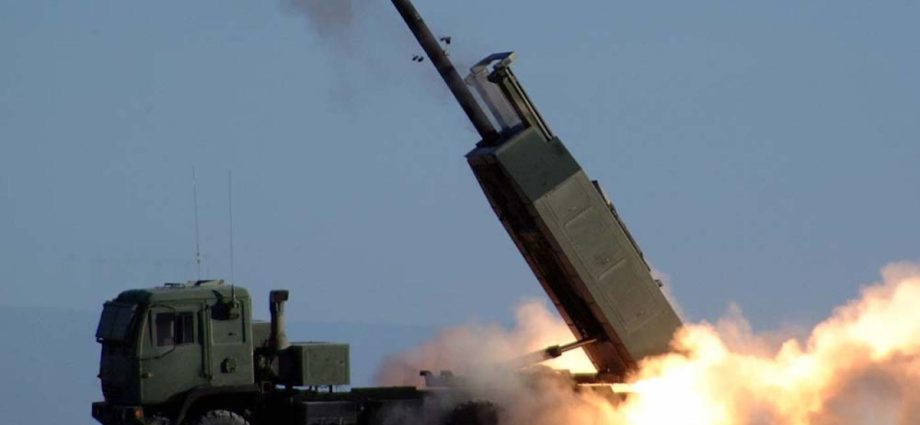
Australia continues to stock up on long-range precision firepower to deter China’s rapidly growing military footprint in the Pacific, with the first test-firing of the US Army Tactical Missile System (ATACMS) in its territory underscoring that effort.
This month, The Warzone reported that the US Army fired the ATACMS for the first time in Australia during the ongoing Exercise Talisman Saber 2023 in the latter’s territory.
The source notes that a High Mobility Artillery Rocket System (HIMARS) from the US Army’s 17th Field Artillery Brigade fired the ATACMS, with a US Air Force MC-130J Commando II aircraft moving the rocket launcher into position from eastern Australia to the Northern Territory.
The Warzone notes that the HIMARS is designed to be air-transportable and have good cross-country mobility, since moving military assets within Australia, much more than in the Pacific, requires significant logistical effort.
As for the ATACMS variant fired during the test, the source notes that the missile flew 260 kilometers to the Bradshaw Field Training Area target area, hitting the target with a high-explosive unitary warhead.
It says the ATACMS version used in the test was the MGM-161A, introduced in the early 2000s, which has a 226-kilogram warhead with a range of 300km. The Warzone notes that that missile can be used against static fortified targets with high terminal speed, enabling it to burrow into the ground and destroy underground structures.
HIMARS tested
Aside from the ATACMS, the US has also recently tested the HIMARS system in Australia. Early this month, Australia Defence Magazine reported that two HIMARS rocket launchers from the US Army’s 17th Field Artillery Brigade were deployed for Exercise Highball in Western Australia, aiming to develop how the Australian Defense Force (ADF) employs long-range land-based precision rocket systems for land and maritime strike roles.
Australia Defence Magazine also said that Exercise Highball responded to the Defense Strategic Review’s direction to accelerate and expand the introduction of long-range land-based maritime strike capabilities, particularly the HIMARS acquisition.
The source noted the urgent need to integrate long-range fires into the ADF’s operational capability and mentioned that using by US Army HIMARS strike package already in Australia for Exercise Talisman Saber 2023, the ADF would accelerate its understanding of employing and projecting the weapons system.
It also said Exercise Highball would enhance US interoperability with the ADF’s targeting capabilities and the operational employment of land-based, precision multi-domain fires.
In connection with that, Asia Times reported in January that Australia had finalized the purchase of 20 HIMARS rocket launchers to be delivered in 2026 while signing a separate agreement for Norwegian naval strike missiles (NSMs) to replace the aging US-made Harpoon anti-ship missiles on its Hobart-class destroyers and Anzac-class frigates in 2024.
Those purchases are intended to improve Australia’s long-range strike capabilities, with ATACMS and HIMARS enabling it to hit targets 300km away. Also, Australia has a joint program with the US to develop a precision-strike missile that can hit targets beyond 499km.
The deployment of HIMARS by Australia in Southeast Asia or the Pacific is being considered, following the US Marine Corps example. The USMC has been exercising with the system under the presumption that it would need to be deployed somewhere in those regions during a clash over Taiwan or the South China Sea.
Also, the stealthy sea-skimming NSMs would double the range of Australia’s warships to 185km.
Moreover, Asia Times reported in July 2022 that aside from the HIMARS and NSM, the US has approved the US$235 million sale of 80 units of the Joint Air-to-Surface Standoff Missile – Extended Range (JASSM-ER) to Australia. Those stealthy cruise missiles could be launched from the Royal Australian Air Force’s F-35 Lightning II or F/A-18F Super Hornet fighters, giving Australia much-sought-after long-range strike capabilities.
China’s perceived risk to Australia’s strategic security may have figured heavily in the latter’s decision to acquire long-range strike capabilities.
China’s rapidly improving long-range strike capabilities centered on bombers, submarines and missiles have put US military facilities in Australia within striking range, and its increasing footprint in Solomon Islands may be a prelude to a more significant military presence that can cut off Australia from the US and New Zealand.
Refueling challenge
The RAAF’s F-35 Lighting IIs do not have the range to reach the South China Sea and Taiwan without aerial refueling. Also, aerial tankers may not always be available over contested airspace.
Using Indonesian airspace to support Australian aerial refueling operations may be a hard sell, as the former does not allow its territory to be used as a military facility base for any other country. Hence Australia needs long-range strike capabilities that can operate from its own or friendly territories in the Pacific to impose unacceptable costs on potential adversaries.
However, Australia might blind-fire its long-range missiles without long-range intelligence, surveillance, and reconnaissance capabilities.
In a January article for The Strategist, Malcolm Davis notes that while Australia urgently needs long-range strike capabilities, it needs to see far to shoot far. However, Davis points out that China’s improving anti-access/area denial (A2/AD) capabilities can put Australia’s P-8A Poseidon maritime patrol aircraft and MQ-4B Triton drones at risk and reduce their time on station.
At the same time, he says Australia’s nuclear attack submarines (SSN-AUKUS) will not be ready until the 2030s. Davis notes that surface warships would be increasingly vulnerable to long-range missiles and surveillance systems.
Given those threats, Davis advocates space-based ISR (intelligence, surveillance and reconnaissance) capabilities for hemispheric surveillance and long-range strike, recommending Australia have its low Earth orbit (LEO) satellite constellation to provide high-resolution imagery and precision tracking.
He also says that such an LEO satellite constellation would follow a “small, cheap, and many” design philosophy, making it difficult to attack and easy and cheap to maintain, and would ensure strategic independence when it comes to that critical military capability while allowing for interoperability with allies and partners.

